The 360c Square: A Design
by
Charles William Johnson
|
Science in Ancient Artwork Series
No.35
New Orleans, Louisiana.
|
|
The 360c Square: A Design
by
Charles William Johnson
|
Science in Ancient Artwork Series
No.35
New Orleans, Louisiana.
|
The 360c Square: a DesignTable of Contents
THE 360c SQUARE: A DESIGNBy
IntroductionIn our previous essay (Earth/matriX N.34), we illustrated the manner in which the 360c day-count calendar may have been derived from a grid based on a 36 x 36 square. The numbers that appear on the 36c square are relevant to the numbers found in the historical record of the reckoning system of ancient Mesoamerica. The numbers are listed on the 36c square in multiples of the 36c integer, and then added to one another in a progression. The 36c integer is multiplied 1-36 times. The 36c square produces the following set of numbers:
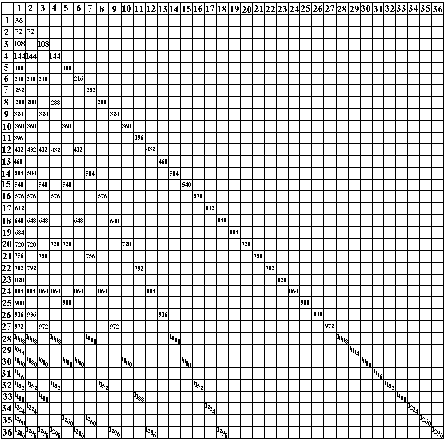
From this grid, one may obtain the idea of creating other grid arrangements. Different designs and patterns obtain from the number of squares on the grid. It may become obvious to the reader that this may have constituted a particular procedure for creating distinct designs and patterns in various ancient cultures.
Grids and PatternsOne of the most striking aspects of ancient artwork is the geometrical nature of many of the designs and patterns. Geometry is translation of numbers into spatial configurations. Hence, the study of the logic of numbers of the ancient reckoning system serves as a sound basis for considering the nature of certain designs and patterns. For, as we shall observe in this essay, it is possible to consider the artwork as of specific numerical progressions and mathematical models. Many authors have examined ancient artwork precisely from the perspective of its possible mathematical expression and translation. We shall consider similar ideas in this essay. Once we observed the pattern that obtained from the 36c square listed above, we considered the possibility of creating squares that would reflect other numerical combinations. But, before we effected the analysis of other numbers, we constructed a possible pattern as of the 36c square itself. It is well-known that the ancients considered the number 4 to be extremely significant; especially, the idea of the four directions (not to mention up and down for now). Therefore, we proceded to take the 36c square pattern that was derived from the 36c square itself and repeat it four times for every direction on the grid. The following pattern was observed:

Basically, the essential pattern revealed by the 36c square is revolved on its innate axis for each side of the grid. The pattern that evolves is quite suggestive of many designs found in the historical record, especially of the ancient cultures of the Western hemisphere, although one may perceive similarities of design with the artwork from other cultures around the world. It all depends upon how one views the pattern produced on the grid; that is, which elements are viewed at a particular moment and from a specific perspective. The most obvious aspects of the pattern are the four pyramid-like structures or profiles that are produced, and the central crisscross axis. Other aspects that come to mind immediately are the quatrefoil-like patterns and the parquetry-like designs of ancient times. But, even more recognizable are some of the specific designs employed on the pyramids of the different cultures of ancient Mesoamerica; the grecas, the repeat patterns that line the walls of those pyramidal structures.
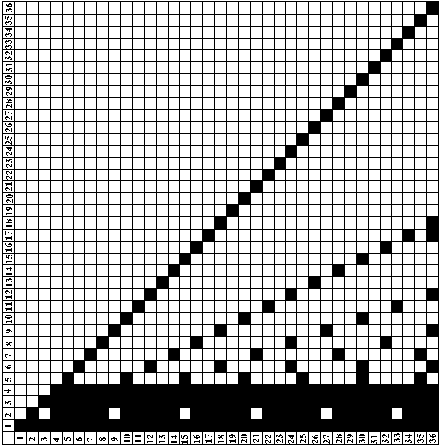
A possibility that has always impressed us is to consider the grecas as having a particular numerical value or valence, representing specific relationships among the planetary bodies. In the following illustrations, we shall be able to perceive and recognize other configurations that are highly suggestive of some of those ancient designs on the pyramids of Mesoamerica. The 36c square pattern, in its single presentation, is
obtained by filling in the corresponding square on the grid in the following
manner. More simply stated: each column is an expression of its own number, added to itself in progression. However, we wished to offer the corresponding numbers in order to be able to visualize the patterns numerically. In this essay, however, we shall attempt to visualize the patterns in terms of space; not numbers as such.
Same pattern in squaresNow, following this same pattern of filling in the blanks on the different squares will produce the patterns and designs that are herein illustrated. The reader may note that the first four squares (numbers 1-4) cancel themselves out:

In one repeats the above pattern of annotation on the different squares, then all of the spaces will be filled for the numbered squares 1-4. There will be no blank spaces appearing. Only on the square number 5 do blank spaces thus appear as of this pattern of annotation:

After following the pattern of annotation for the four sides, four blank spaces remain. In a sense, from this perspective of design, something has been 'created', and one could easily understand how the number 5 may have come to reflect the idea of creation or the Creator in some ancient cultures: if a pattern of numbers was being employed similar to this one. (It shall be impossible for us to repeat each individual step for each one of the grid/squares included in this essay dues to requirements of space.) The next square, of the number 6, now poses a dispersion of the four blank spaces previously observed; it were as though they had moved. From the mere presence of the four blank spaces, one may now observe the concept of 'movement'.
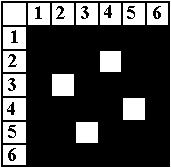
Square Number 7 (7 x 7) represents a qualitative leap from the previous grid pattern. Many more blank spaces appear. But, most striking is the apparent "quinqunce" (quinqunx) design that appears at the center of the grid. It is not exactly as one might expect the quinqunx element to appear, since the center square is left blank and not darkened. Again the number '7' reflects a number of the creation as well in some cultures.
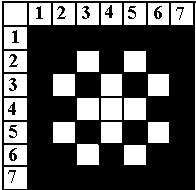
The following square reveals a very strong center of four blackened squares. It also suggests to us a configuration that resembles many ancient designs of a square within a border area:
Also, from another perspective, the concept of movement
would appear to show itself as revolving around the central axis in a
counter-clockwise direction. The four L-shaped figures ( In the square number 9 (9 x 9), the concept of movement really begins to take on a definite visualization pattern. The leftward, circular motion is definitely suggested by the arms of the central figure within the pattern. Another design becomes visible; that is, the T-shaped figure.
The T-shaped figure may be viewed in black or white within the design in relation to one another. This particular design may be found on interior walls within structures of ancient sites. The square number 10 (10 x 10) is an extensive of square number 8 with its L-shaped arms lengthened by one square blank. The square number 11, however, reveals something that this author finds extremely suggestive: five quinqunx-like figures: one at the center and one situated in each corner.
Square number 12
Square number 12 begins to reveal a pyramid-like structure in the making. While square number 13 repeats the five quinqunx-like figures in relation to a definite central figure that shows a quinqunx bordered by four L-shaped figures. Movement is once again suggested by the placement of the quinqunx-like elements and the manner in which the L-shaped figures appear to suggest a counterclockwise motion also.
One can visualize many different patterns and designs within each square/grid. We have selected those which might be related to figures that actually appear in the historical record. However, there are numerous others which we have not referred to here; possibly, in later essays we shall treat similar themes. But, suffice it here to offer the reader some of the more obvious examples. In square number 14, the central four-fold axis and the T-shaped extensives suggest movement as well. Square number 15 combines many different figures already examined: the central quinqunx; T-shapes; L-shapes.
In square number 16, the L-shaped figures now take on an ax-like shape, which is suggestive of some of the greca-like configurations in central Mexico (Mitla). The central square and bordered figure returns distinctively. Movement is increased in the visualization of the image. In square number 17, the quinqunx and the pyramid-like structure become more dominant. These views (1-17) should be sufficient to offer an understanding of the pattern and its potential for concepts of design within ancient artwork. Given that these figures are highly suggestive of ancient artwork designs, a similar procedure may have been followed in creating some of the ancient designs. The 26c Square One could offer a square along this pattern of annotation for every significant number of the ancient reckoning system, which might not be excessive if we begin to observe distinct patterns appear that are similar to those found in the historical record. For now, let us draw attention to the square/grid of the 26c fractal count, that would correspond to the 260c reckoning system of ancient Mesoamerica.
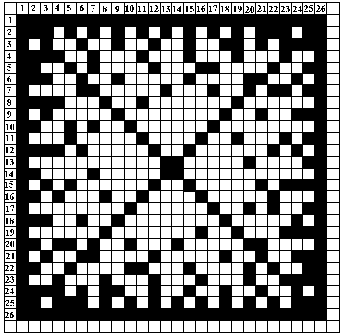
In some of the squares, there appears an off-center, square-like figure, formed by some of the darkened blanks. The interesting point to note about this square is the formation that may be derived from connecting its corners together at right angles:
To do further justice to this analysis, one would have to now compare the 26c and the 36c squares, alongwith an infinite array of other comparisons. However, we have simply wanted to forward the possible pattern of annotation that could have been followe regarding the 360c square (36 x 36) for now. To mention but one example of numerical comparison:
In one multiples this fraction generated as of the two distinct squares and their multiples, as we have done here then the following obtains:
|
|||||||||||||||||||||||||||||||||||||||||||||||||||||||||
Your comments and suggestions are greatly appreciated:
|
|||||||||||||||||||||||||||||||||||||||||||||||||||||||||
Earth/matriX:
Science in Ancient Artwork Series ISSN-1526-3312 |